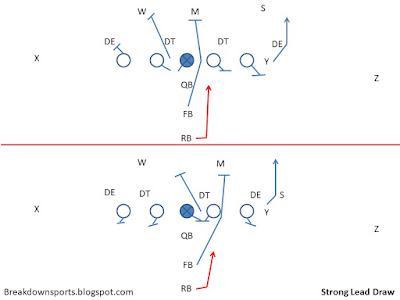Football Fundamentals: I-Formation RB Draw Plays
This is a series post with lots of play diagrams. Where it lacks depth, it hopefully makes up for with breadth. The goal of this post is to demonstrate the many run game nuances that are at your disposal, outside the very basics that you can find almost anywhere. I will point out some key attributes for the plays, but for the most part the diagrams will stand alone outside a brief description. This post is limited (out of necessity) to strongside plays that are given directly to the RB. It does not include FB runs, or QB runs, or H-Back, Wing, TE, or WR runs. It also doesn't include option plays. Those are things for future posts.
Why did I select an I-formation, which is mostly going out of fashion, and how do I expect this information to be utilized? The I-Formation is a classic 2-back set that, by the time it was implemented, had the benefit of a lot of football history. It is also a highly adaptable run formation, along for offsets, for H-backs, and other aspects that allow essentially any run concept to be incorporated into its framework. And that's the important bit: you can look at an I-Formation run play and easily carry it forward to many modern formations. For instance, by altering footwork and possibly timing, any of these plays can be utilized in the following:
Why did I select an I-formation, which is mostly going out of fashion, and how do I expect this information to be utilized? The I-Formation is a classic 2-back set that, by the time it was implemented, had the benefit of a lot of football history. It is also a highly adaptable run formation, along for offsets, for H-backs, and other aspects that allow essentially any run concept to be incorporated into its framework. And that's the important bit: you can look at an I-Formation run play and easily carry it forward to many modern formations. For instance, by altering footwork and possibly timing, any of these plays can be utilized in the following:
- 2-Back Shotgun Runs (with the second back potentially being a FB, an H-Back, a Wing, or a Sniffer)
- 1-Back Shotgun QB Runs (utilizing the RB as an added blocker)
- 1-Back Shotgun Read Options (the read of a run-run option, run-pass option, or pass-run option take the place of the additional blocker).
Many of the best current offenses often circle back to old formations. In the NFL, along with the modern spread concepts, you see a lot of the best offenses utilizing Wing T concepts. This set of plays does the same where it can (though, again, recognize that the option packages and fake packages are not included in this post, so it is somewhat limited). Below, you will see each play blocked against the two fundamental Even Fronts (4-3 Over and Under).
Isolation Plays
Gap and Pull Plays
Fold and Trap Plays
Counter Plays
Pull Replace Plays
Zone and Zone Counter Plays
Zone/Gap Combo Plays
Draw Plays
Gap and Pull Plays
Fold and Trap Plays
Counter Plays
Pull Replace Plays
Zone and Zone Counter Plays
Zone/Gap Combo Plays
Draw Plays
In this final post, we will be looking at draw plays.
The classic lead draw play is effectively an Iso run with draw blocking technique.
Dive Draw
Another isolation run play, but this time with the FB going opposite the RB.
Kick Draw
The FB now accounts for the frontside EMOL, which allows for the RB to go the clearest of the B-gap to bounce outside.
Short Trap Draw
A short trap play where the OG will initially pass drop underneath a pinning C before releasing one defender over and kicking him outside.
Trap Fold Draw
First a trap draw, and once the trap is set, the OL over the trap defender folds underneath the trap blocker to lead through the hole for the RB.
Long Trap Draw
Now the OG is kicking out the DE, allowing for a wider draw play against a defender more susceptible to getting upfield and taking himself out of the play.
Inside Fold Draw
Center of Guard fold up to the MIKE in a version of an isolation play.
Outside Fold Draw
The fold is now to the frontside of the formation leading to the frontside LB. The FB will kick the playside DE.
Gut Fold Draw
Two OL fold inside to become the fold blockers. Here, the TE stays in to block the EMOL and the FB releases into a route to hold the SAM.
Bounce Draw
The Bounce Draw is a play specifically designed to reach the edge.
Lead Sprint Draw
Sprint out look up front, the FB peels back and leads through to the WILL.
Sally Draw
Much like the Wing T Sally play, we now show sprint out but pull the guard up to the WILL
Wrap Draw
Another sprint draw, this time with the Tackle pulling back to the WILL with the FB replacing to the EMOL.

















Can you do a post on how teams choose what their base plays should be? Why would you choose one run concept over another to base out of? How does personnel effect this.
ReplyDeleteAlso, how does a team take advantage of star offensive linemen. What if you have a star guard(for example) do you run more inside runs to his side? What if your base play is more of an outside run would you change your base play to take advantage of your star?
You do great work on this blog.